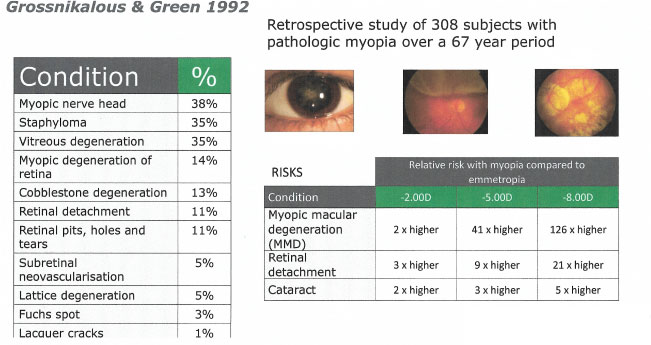

Refractive error is measured in dioptres (D), and myopia is designated with a minus sign. When the optical components focus the image perfectly on the retina, this is described as emmetropia, and when the eye focuses the image behind the retina, this is described as hyperopia. In myopia, the image is focused in front of the retina because the cornea or lens curvature is too strong or the eye is too long (axial myopia). The main ocular determinants of refraction are the focusing power of the cornea and crystalline lens and the length of the eye.

To obtain clear vision, the eye must accurately focus an image in space on the retina. Understanding the mechanisms and factors that affect ocular growth is prerequisite to development of these therapeutic strategies. Since no current treatments can reverse the structural changes of pathological myopia, preventing myopia has long been a goal of ophthalmologists and scientists researching vision. 7 As the prevalence of simple myopia increases, the incidence of pathological myopia may also increase. In the United States, for example, the treatment of myopia costs an estimated $250m (£173m, €281m) per year. 6 In addition to the human cost of visual disability, there is a profound economic cost to society. 5 The prevalence of pathological myopia is estimated at 1-3% in population based studies. 4 According to epidemiological evidence the prevalence of myopia is increasing, especially in Asian populations. 2, 3 In Japan it is estimated that more than one million people suffer from vision impairment associated with high myopia. The prevalence of myopia varies by country and by ethnic group, reaching as high as 70-90% in some Asian populations. High (pathological) myopia often leads to atrophy of the choroid and subsequent retinal macular degeneration, with loss of central visual acuity and high incidence of retinal detachment, glaucoma, and strabismus Simple myopia can be corrected with spectacles or contact lenses, whereas “high” (pathological) myopia is often associated with potentially blinding conditions such as retinal detachment, macular degeneration, and glaucoma (fig (fig1 1). 1 People with myopia can be classified in two groups, those with low to modest degrees of myopia (referred to as “simple” or “school” myopia, 0 to −6 dioptres) and those with high or pathological myopia (greater than −6 dioptres). The World Health Organization has grouped myopia and uncorrected refractive error with cataract, macular degeneration, infectious disease, and vitamin A deficiency among the leading causes of blindness and vision impairment in the world. Myopia, commonly referred to as shortsightedness, is a common cause of visual disability throughout the world. This review article was prepared by searching Medline for citations of articles in English using the keyword “myopia.” In addition, abstracts from the annual meetings of the Association for Research in Vision and Ophthalmology were reviewed.


 0 kommentar(er)
0 kommentar(er)
